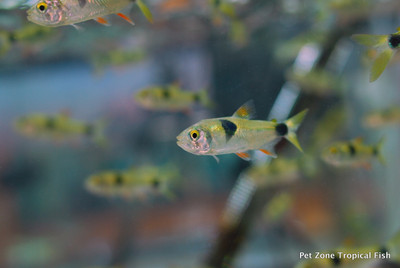The Bucktooth Tetra: Unveiling the Charismatic Enigma of Aquaria
Posted by Max Gandara on on 16th Apr 2024
The Bucktooth Tetra: Unveiling the Charismatic Enigma of Aquaria
In the vast tapestry of freshwater aquarium fish, the Bucktooth Tetra (Exodon paradoxus) stands out as a captivating and enigmatic species. Known for its striking appearance, energetic demeanor, and unique feeding behavior, this South American native has earned a devoted following among aquarists seeking a touch of excitement and intrigue in their tanks.
Origins and Habitat: The Bucktooth Tetra is indigenous to the waterways of South America, specifically the Amazon River basin and its tributaries. It inhabits densely vegetated areas, including flooded forests, slow-moving streams, and oxbow lakes, where it can find ample shelter and abundant prey. These habitats are characterized by warm, acidic water with a plethora of aquatic plants, fallen branches, and submerged roots.
Physical Characteristics: True to its name, the Bucktooth Tetra boasts a distinctive feature that sets it apart from other tetra species: prominent, elongated teeth. These teeth, which protrude conspicuously from the lower jaw when the fish's mouth is closed, give it a somewhat comical appearance reminiscent of a mischievous grin. Apart from this unique trait, the Bucktooth Tetra sports a streamlined body adorned with iridescent scales that shimmer with hues of silver, gold, and blue, adding to its visual allure.
Behavior and Temperament: Despite its charming appearance, the Bucktooth Tetra is a voracious predator known for its aggressive feeding behavior. In the wild, it preys on smaller fish, crustaceans, and insect larvae, using its sharp teeth to grasp and immobilize its prey. In captivity, it may exhibit similar behavior, often targeting smaller tank mates or even nipping at the fins of larger companions. As such, it is best kept in a species-only tank or with robust, fast-swimming companions that can hold their own against its predatory instincts.
Diet and Feeding: Feeding the Bucktooth Tetra is a spectacle unto itself, as it eagerly devours live prey with gusto. In its natural habitat, it feeds on a varied diet of small fish, insects, crustaceans, and other aquatic invertebrates. In captivity, it readily accepts live or frozen foods such as bloodworms, brine shrimp, daphnia, and blackworms. It may also consume high-quality flakes or pellets, although live foods are preferred and help stimulate its natural hunting instincts.
Tank Requirements: Providing suitable habitat conditions is essential for the health and well-being of the Bucktooth Tetra. A tank size of at least 30 gallons is recommended to accommodate its active nature and predatory behavior. Dense vegetation, driftwood, and hiding places should be provided to mimic its natural habitat and offer shelter. Live plants such as Java Moss, Amazon Sword, and Vallisneria not only enhance the aesthetics of the tank but also provide refuge for the fish.
Water parameters should be maintained within a temperature range of 75-82°F (24-28°C), with a slightly acidic to neutral pH level (6.0-7.0) and soft to moderately hard water. Filtration and regular water changes are essential to ensure water quality and prevent the buildup of waste products.
Breeding: Breeding the Bucktooth Tetra in captivity can be challenging due to its predatory nature and aggressive behavior. However, with careful planning and suitable tank conditions, it is possible to encourage spawning. A separate breeding tank with dense vegetation, subdued lighting, and slightly acidic water should be set up. Conditioning the fish with a varied diet of live foods can help stimulate breeding behavior.
Once spawning occurs, the eggs will adhere to the vegetation or substrate, where they will hatch within a few days. The fry can be fed with infusoria or commercially available fry food until they are large enough to accept finely crushed flakes or baby brine shrimp.
The Bucktooth Tetra is a captivating and charismatic species that adds a touch of excitement to freshwater aquariums. With its striking appearance, energetic demeanor, and unique feeding behavior, it never fails to captivate the imagination of aquarists. By providing suitable habitat conditions and a varied diet, enthusiasts can enjoy the fascinating presence of these enigmatic fish in their tanks.

